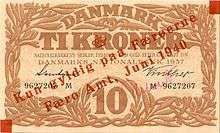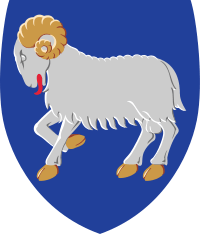Faroese króna
The króna (plural: krónur; sign: kr) is the currency of the Faroe Islands. It is issued by Danmarks Nationalbank (Danish National Bank), the central bank of Denmark. It is not a separate currency, but is rather a local issue of banknotes denominated in the Danish krone, although Danish-issued coins are still used. Consequently, it does not have an ISO 4217 currency code and instead shares that of the Danish krone, DKK. The króna is subdivided into 100 oyru(r).
| Faroese króna | |
|---|---|
| føroysk króna (Faroese) færøsk krone (Danish) | |
| ISO 4217 | |
| Code | FOK[lower-alpha 1] |
| Denominations | |
| Subunit | |
| 1/100 | oyra |
| Plural | krónur |
| oyra | oyru(r) |
| Symbol | kr |
| Banknotes | 50, 100, 200, 500, 1000 krónur |
| Coins | 50 oyru(r), 1, 2, 5, 10, 20 krónur |
| Demographics | |
| User(s) | |
| Issuance | |
| Central bank | Danmarks Nationalbank |
| Website | www |
| Valuation | |
| Inflation | -1,1% |
| Source | The World Factbook, 2009 |
| Pegged with | Danish krone at par |
| |
History
When German forces invaded and occupied Denmark on 9 April 1940, the Danish krone was used in the Faroes. However, all exchange between the Faroes and Denmark halted as a result of the occupation, leaving one currency to develop in two markets independently of each other. On 31 May 1940, special Faroese banknotes were introduced. They consisted of Danish notes with a special stamp. These notes replaced unstamped Danish at par.[1]
From 14 October 1940, new banknotes were printed "on behalf of the National Bank of Denmark."[2] The value of these new banknotes was the same as those already in use. On 18 December 1940, a Currency Central was established in order to monitor foreign trade and to secure the solvency of the Faroes. Currency Central was headed by a board of nine, the judge, who was chairman, one representative of Faroe Fish Export, one representative of the Faroese Merchants' Union, one representative of the bank Føroya Banki, one representative of the savings bank Føroya Sparikassi and four representatives of the Løgting.[3]
On 18 December 1940, the Faroese króna was pegged to the British pound at a rate of 22.4 krónur = 1 pound.[4] This rate was officially accepted by the British government in a treaty titled "Agreement between His Britannic Majesty's Government and the Administration of the Faroe Islands, for Regulating the Financial Relations between the United Kingdom and the Faroe Islands," which came into force on 27 March 1941.[5] At the same time, the Board of the Currency Central was reorganised to only three members, one representative of the British Government, one representative of the State (referring to the State of Denmark, meaning the County of Faroe), and one representative of the Løgting or the parliamentary National Board.[6] In 1941, coins were struck in London for use on the Faroe Islands.
As of 12 April 1949, the Faroese króna was separated from the pound sterling and fixed to the Danish krone at parity.[7] This arrangement is still in effect. Although Faroese banknotes were issued "on behalf of the National Bank of Denmark," the National Bank of Denmark does not claim any rights to Faroese banknotes issued prior to 1951.[8]
Exchange with the Danish krone
Danish kroner are exchanged to Faroese krónur and vice versa by the National Bank of Denmark free of charge. While normal Danish bank notes are no longer intended as legal tender in the Faroes, they are accepted there in all situations. In Denmark proper, existence of the Faroese króna is poorly known, particularly the fact that it is officially the same currency as the Danish krone and that the notes can be exchanged by any Danish bank without charge. Consequently, very few Danish stores will accept Faroese notes. Also, exchange offices in other countries often have problems with them. People travelling from the Faroes are often advised to exchange their cash prior to embarking in order to prevent potential complications arising from this situation.
Coins
The Faroe Islands use standard Danish coinage, but the region has experienced a shortage of small currency on several occasions, leading to non-standard issues.
During the late 19th century, German national C.F. Siemsen, a merchant conducting business in both the Faroe Islands and Iceland, issued his own private coinage. This issue is brass, one side carrying the inscription: CFS and the other side the denomination: 4 or 16 skilling in goods ("x SKILLING I VARE"). Due to a shortage of currency in 1929-33, two merchants issued their own coins as well; J.F. Kjølbro in Klaksvík and S.P. Petersens Eftf in Fuglafjørður. The Kjølbro issue is aluminium coins with denominations of 10, 25 and 50 øre, and 1, 2, 5, and 10 kroner. S.P. Petersens Eftf's issue was made of brass in denominations of 5, 10 and 25 øre, and 1, 2 and 5 kroner.[9]
During World War II, the Faroe Islands were separated from Denmark proper due to the occupations by the United Kingdom and Germany respectively. In 1941, a set of coins (1, 2, 5, 10 and 25 øre) was minted in London to alleviate a shortage of small change. This issue was identical to the pre-war Danish coinage already circulating, but is easily identified: the coins minted in London were made of bronze and copper-nickel, while the comparable coins minted in Denmark in 1941 were made of aluminium and zinc (with one exception). In addition, the British made set lacks both the mark of the Royal Danish Mint (a small heart) and the initials of the engraver and the mint master in Copenhagen.
Banknotes

In 1940, Danish 5, 20, 50, 100 and 500 kroner notes were overstamped with Kun Gyldig paa Færøerne, Færø Amt, Juni 1940 (meaning “Only valid on the Faroe Islands, Faroe County, June 1940”) for issue on the Faroe Islands. Later that year, the Færø Amt issued distinct notes in denominations of 1, 5, 10 and 100 kroner. From 1951, notes were issued with texts in Faroese. The 1 kroner note was not continued, with 50 krónur introduced in 1967, followed by 500 and 1000 krónur in 1978, 20 krónur in 1986 and 200 krónur in 2003. Between 2001 and 2005, a new banknote series with new security features was introduced to replace older notes. Denominations are 50, 100, 200, 500 and 1000 krónur. On March 19, 2012 an updated version of the Faroese króna banknotes was released into circulation. The new notes are identical to the current issues, but the new notes now feature "Motion" windowed security threads and perfect registration devices instead of holographic patches on the fronts, and mother-of-pearl threads and fluorescent colors added on the back of the notes.[10]
| Image | Value | Dimensions | Main colour | Description[11] | Date of issue | |
|---|---|---|---|---|---|---|
| Obverse | Reverse | |||||
| 50 kroner | 125 × 72 mm | Blue-grey | Ram's horn | Cliff near Sumba | 3 July 2001 | |
| 100 kroner | 135 × 72 mm | Gold | Cod's tail | Klaksvík | 16 January 2003 | |
| 200 kroner | 145 × 72 mm | Purple | Ghost moth | Tindhólmur | 19 January 2004 | |
| 500 kroner | 155 × 72 mm | Blue-green | Shore crab | Hvannasund | 30 November 2004 | |
| 1000 kroner | 165 × 72 mm | Red | Purple sandpiper | Sandoy | 15 September 2005 | |
Bank transfers
For international bank transfers including credit card transfers the ISO code has to be given. The Faroese króna has no official ISO 4217 code, so DKK is used for all credit card statements for visitors and international transfers of krónur (unless some other currency is used). Still transfers between Denmark and the Faroe Islands count as international with corresponding fees, and the Faroe Islands have it own IBAN and BIC codes with FO in them.
Current exchange rates
| Current DKK exchange rates | |
|---|---|
| From Google Finance: | AUD CAD CHF EUR GBP HKD JPY USD |
| From Yahoo! Finance: | AUD CAD CHF EUR GBP HKD JPY USD |
| From XE.com: | AUD CAD CHF EUR GBP HKD JPY USD |
| From OANDA: | AUD CAD CHF EUR GBP HKD JPY USD |
| From fxtop.com: | AUD CAD CHF EUR GBP HKD JPY USD |
Numismatics
Faroese banknotes may be purchased by collectors at face value from Danmarks Nationalbank. (Postverk Føroya, the Faroese postal service now known as 'Posta', used to be the sole supplier of Faroese banknotes to collectors, but does not sell banknotes anymore.)
See also
- Exchange rate regime
- British occupation of the Faroe Islands in World War II
- Economy of the Faroe Islands
References
- Færöernes Kundgörelsessamling 1940, p. 7 - Gazette of the Faroes (in Danish)
- Færöernes Kundgörelsessamling 1940, p. 40 - Gazette of the Faroes (in Danish)
- Færöernes Kundgörelsessamling 1940, p. 62-64 - Gazette of the Faroes (in Danish)
- Færöernes Kundgörelsessamling 1940, p. 62-64 - Gazette of the Faroes (in Danish)
- Færöernes Kundgörelsessamling 1941, p. 19-21 - Gazette of the Faroes, (in Danish and English)
- Færöernes Kundgörelsessamling 1941, p. 22 - Gazette of the Faroes (in Danish)
- Lov nr. 248 frá 12. april 1949 om pengesedler m.v. på Færøerne Archived 2005-10-27 at the Wayback Machine - Act about Banknotes and more on the Faroes. (in Danish)
- The previous Faroese banknote series Archived 2006-06-19 at the Wayback Machine - The National Bank of Denmark.
- Siegs Møntkatalog, "Norden", 2002 edition, pages 314-315 (in Danish)
- Faroe Islands new note family confirmed BanknoteNews.com. Retrieved 2012-05-17.
- "Banknotes and Coins of the Kingdom of Denmark" (PDF). nationalbanken.dk (1st ed.). Danmarks Nationalbank. August 2012. pp. 20–21. Retrieved 3 July 2020.
- Krause, Chester L.; Clifford Mishler (1991). Standard Catalog of World Coins: 1801–1991 (18th ed.). Krause Publications. ISBN 0873411501.
- Pick, Albert (1994). Standard Catalog of World Paper Money: General Issues. Colin R. Bruce II and Neil Shafer (editors) (7th ed.). Krause Publications. ISBN 0-87341-207-9.
External links
| Wikimedia Commons has media related to Faroese króna. |
- The banknotes of the Faroe Islands (in English and German)
- Unofficial.
